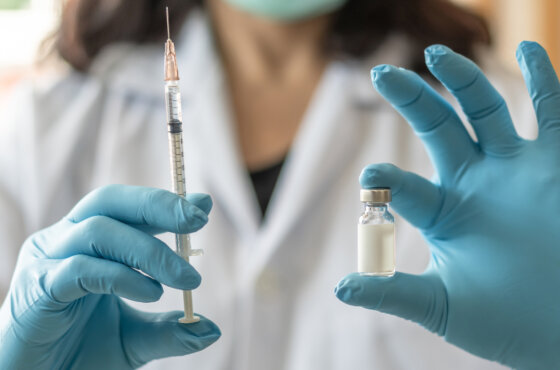Palmitoyl Tripeptide-5: Studies on Skin Cells
Studies suggest that increasing the formation of collagen type I may be the purpose of the synthetic peptide known as Syn-Coll. It has been hypothesized that the action mechanism may involve the activation of converting growth factor-β (TGF-β), and may impact the depth and length of wrinkles and skin cell hydration.

Credit: iStock.com/ArisSu
Peptide Sequence: Palmitoyl-Lys-Val-Lys
Chemical Formula: C33H65N5O5.
Molecular Weight: 611.9 mol
Investigations are now being conducted to decide whether Syn-Coll may increase the production of type I and type III collagen. Skin, bone, and muscle cells all comprise type I collagen. Both the lungs and the circulatory system contain type III collagen. Type III collagen may also be found in the skin structure. As suggested by research conducted on animals, Syn-Coll may have the potential to enhance the structural strength of skin cells, facilitate tissue repair, and potentially enhance the vascular supply to the skin cells, improving the skin’s moisture retention by enhancing the synthesis of collagen.
Syn-Coll Peptide: Mechanism of Action
Syn-Coll, also known as Tripeptide-5 or Palmitoyl tripeptide-5, is a synthetic peptide that resembles a sequence of the protein thrombospondin 1 (TSP-1). Investigations purport that Syn-Coll may effectively prevent collagen breakdown via the activation of TGF-β through TSP-1.
TSP-1 is a naturally occurring molecule that can boost TGF-β activity. Syn-Coll has been theorized to imitate the effects of TSP-1. TGF-β is responsible for a continuous rise in type I and III collagen produced by dermal (skin) fibroblasts. Syn-Coll has been speculated to boost collagen synthesis in animal trials by two to three times the levels initially measured. Before beginning to fade away, the effects seem to last for around three days and three nights. Since TSP-1 is a protein in the extracellular matrix (ECM), it is located in the skin close to collagen and elastin. Activation of latent TGF-β is facilitated by certain components of TSP-1, which are gathered for use in Syn-Coll. In investigations conducted in the laboratory and on animal models, TSP-1 has been indicated to promote wound healing by acting locally on dermal fibroblasts produced in tissue culture. In addition, it is believed to have a role in the postnatal development of skin structures.
Additionally, it is believed that Syn-Coll may deactivate matrix metalloproteinase 1 and 3 (MMP1 and MMP3), enzymes that play a significant role in collagen breakdown. Even though these enzymes play a part in the normal recycling of collagen over time, they may demonstrate a significant increase in expression when inflammation is present. This may result in premature damage to the skin, including the development of wrinkles, creases, and other skin imperfections.
Syn-Coll Peptide and Wrinkles
In research focusing on skin cells, heavy emphasis has been placed on understanding what leads to the development of collagen proteins. This may be accomplished by boosting collagen synthesis or decreasing collagen breakdown. Although just a few factors might boost collagen production, research on animals suggests that Syn-Coll may have the potential to boost collagen production by as much as 119%. Further in vitro tests suggest that Syn-Coll may inhibit collagen degradation by MMP1 and MMP3, preventing collagen breakdown. Findings imply that Syn-Coll may be a two-in-one product that might increase collagen production and reduce the amount of collagen broken down. Syn-Coll seems to be about 3.5 times more effective than a placebo in reducing the appearance of wrinkles. Compared to Palmitoyl pentapeptide, it is believed to be 60% more effective.
Syn-Coll Peptide and Collagen Degradation
The matrix metalloproteinases, often known as MMPs, are a set of enzymes well-studied for their essential function in the degradation of extracellular matrix proteins, particularly collagen. In most cases, dermal cells, such as fibroblasts, may produce these enzymes. These enzymes appear to play an important role in the processes associated with tissue remodeling and preserving the extracellular matrix. Nevertheless, it is essential to consider that abnormal overexpression or dysregulation of matrix metalloproteinases (MMPs) has been associated with a function contributing to dermal collagen breakdown. Particularly noteworthy is that MMP-1 is an enzyme with a particular proficiency in the breakdown of type I collagen.
There is a possibility that the synthesis of MMP-1 by fibroblasts might be increased when certain variables are present, such as ultraviolet (UV) radiation, inflammatory stimuli, and oxidative stress. MMP-3, another notable member of the MMP family, has a wide substrate specificity. Scientists believe this specificity may allow it to cleave many extracellular matrix proteins, including collagens, laminin, fibronectin, proteoglycans, and elastin. MMP-3 is a member of the MMP family. The fact that it is thought to be able to target type II collagen, which is a main structural component of cartilage, is particularly notable. Furthermore, MMP-3 has been suspected of being involved in the breakdown of other forms of collagen, such as type III collagen, which is abundant in skin and blood vessels.
Scientists speculate that Syn-Coll (Palmitoyl Tripeptide-5) may suppress collagen degradation by inhibiting the matrix metalloproteinases involved in collagen breakdown. Specifically, scientific research findings suggest that Syn-Coll (palmitoyl tripeptide-5) may provide protective action by interfering with the processes mediated by MMP1 and MMP3, which are essential to the destruction of collagen.
References
[i] Thorsen, M., Yde, B., Pedersen, U., Clauden, K. & Lawesson, S.-O. Studies on amino acids and peptides-V. Tetrahedron 39, 3429–3435 (1983)
[ii] Trookman, N. S., Rizer, R. L., Ford, R., Ho, E. & Gotz, V. Immediate and Long-term Clinical Benefits of a Topical Treatment for Facial Lines and Wrinkles. J. Clin. Aesthetic Dermatol. 2, 38–43 (2009).
[iii] Varga, J., Rosenbloom, J. & Jimenez, S. A. Transforming growth factor beta (TGF beta) causes a persistent increase in steady-state amounts of type I and type III collagen and fibronectin mRNAs in normal human dermal fibroblasts. Biochem. J. 247, 597–604 (1987)
[iv] Murphy-Ullrich, J. E. & Poczatek, M. Activation of latent TGF-beta by thrombospondin-1: mechanisms and physiology. Cytokine Growth Factor Rev. 11, 59–69 (2000)
[v] Palmitoyl Tripeptide-5: How to Boost and Protect Skin’s Collagen. Available at: http://www.henrytianus.com/site/1345939/page/4655482.
[vi] Bucay, V. W. & Day, D. Adjunctive Skin Care of the Brow and Periorbital Region. Clin. Plast. Surg. 40, 225–236 (2013).
[vii] Kim, H. M., An, H. S., Bae, J. S., Kim, J. Y., Choi, C. H., Kim, J. Y., Lim, J. H., Choi, J. H., Song, H., Moon, S. H., Park, Y. J., Chang, S. J., & Choi, S. Y. (2017). Effects of palmitoyl-KVK-L-ascorbic acid on skin wrinkles and pigmentation. Archives of dermatological research, 309(5), 397–402. https://doi.org/10.1007/s00403-017-1731-6
[viii] Errante, F., Ledwoń, P., Latajka, R., Rovero, P., & Papini, A. M. (2020). Cosmeceutical Peptides in the Framework of Sustainable Wellness Economy. Frontiers in chemistry, 8, 572923. https://doi.org/10.3389/fchem.2020.572923
Читайте также на ForumDaily:
The Canvas of Our Lives: Graphic Design’s Role in American Culture
Modernizing with Delphi: Strategies for Successful Software Migration
How to Get a Personal Loan for Non-U.S. Citizen? Things to Know
Подписывайтесь на ForumDaily в Google NewsХотите больше важных и интересных новостей о жизни в США и иммиграции в Америку? — Поддержите нас донатом! А еще подписывайтесь на нашу страницу в Facebook. Выбирайте опцию «Приоритет в показе» — и читайте нас первыми. Кроме того, не забудьте оформить подписку на наш канал в Telegram и в Instagram— там много интересного. И присоединяйтесь к тысячам читателей ForumDaily New York — там вас ждет масса интересной и позитивной информации о жизни в мегаполисе.



















